- Civil War Arsenal, Civil War Guns
- Civil War Short Rifles, Confederate Rifles
- Civil War Carbines
- Civil War Long Rifles, Enfields, Richmonds and Springfields
- Civil War Guns of The Civil War Arsenal
- Civil War Swords
- Confederate Knives
- Civil War Guns and Swords
- Civil War History
- Civil War Rifles and Bayonets
Sitting around the house today not knowing what to do, outside the snow is coming down and there calling this the storm of the century with up to 2 feet of snow and 50 MPH winds expected, sounds cold to me….
Anyway I decided to take some photos of my history room, a.k.a. the “Civil War Arsenal”. As you can see many of my antique weapons are displayed throughout the room. I recently had a carpenter build the racks that the rifles are mounted on, all in all I think the racks came out pretty nice and compliment the rifles and corresponding bayonets.
You’ll also notice some D-Handle, Side Knives, Pikes and Artillery Swords displayed as well. Its my opinion that these weapons should be displayed so friends and family can see and handle them. I don’t quite get the fun in collecting antique guns and swords then putting them in the safe or some out of the way place where no one can appreciate them. But thats just my opinion and you know what they say about opinions.
Also scattered throughout the room are a number of paintings, historical photos, bronze castings and dozens of other historical items. You’ll notice that I am a big “John Paul Strain” fan he is perhaps one of the best artist in his field I have a bunch of his paintings. I also have some of “Karl Anderson’s” sculptures, he’s a less know artist then John however just as good and I believe the best in his field, especially when it comes to historical accuracy.
Well there you have it, another story that no one will read. Just Kidding…. If you have any questions about this post or any of the weapons in the “Civil War Arsenal” feel free to contact me at civilwararsenal@yahoo.com attn: Gene West


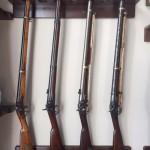
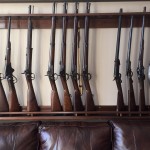
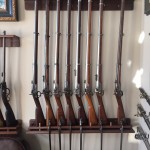
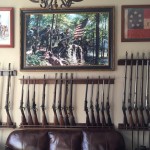
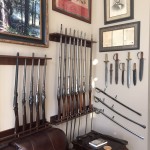
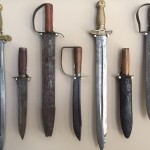
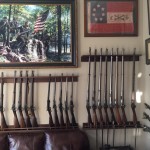
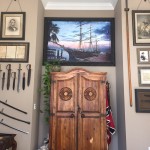

Hello Eugene,
First of all I would like to say how much I enjoyed looking at your website, it really got me thinking.
I have attached a sheet showing a Richmond carbine/musketoon that I have in my collection. The stock lock, barrel bands, trigger guard, butt plate are all Richmond. Not sure about the nose cap, and the swelled ramrod is 1855 pattern with a threaded end. The stock is of the two piece variety with the forearm joined under the lower barrel band.
The barrel is clearly cut down to 30.5 inches and is too large to take a bayonet. The bore is .610 smoothbore. It has numerous minute flaws associated with Richmond barrels but the sight, although found on Confederate arms, I do not think was made there. Also, there is no tee slot cut for it in the top of the barrel. This puzzles me.
Do you think the barrel and sight could be Richmond products?
Love your gun racks, what an excellent way to display without using up too much space.
Good luck,
J
Hello Gene,
Thank you for such a fast reply. I am about to go out for the evening but I will do as you say. Already I can answer some of your questions but will photograph as well.
The front sight I think is wrong but very well made! The mules foot is present, no cartouches seen but I will look again In good light, the butt plate is brass and unmarked, no star but the P has a slight nick on the top part of the curve, other details I will have to check.
Good luck,
J
========================================
Message Received: Jul 21 2015, 03:56 PM
From: “Gene West”
To: “J
Cc:
Subject: Re: Richmond carbine
J
Thanks for the kind words about web site and gun racks, the gun racks were made by a local carpenter and they work great for the application.
The rear sight on the weapon you have is not Southern it is Northern made and if the barrel doesn’t have a cut for the rear sight steady pin it’s an indication that it’s northern made. But the Richmond Armory retooled thousands of Northern weapons that were picked up on the battlefield. Southern foot soldiers would scavenge the battlefields looking discarded weapons in good, bad and indifferent condition. These would then be sent to the Armories to be rebuild and reissued to the troops.
I would love to see more photos of the weapon you have. If you could provide me photos of the.
1. Front sight must be a pinched sight, not the conventional sight found on Springfield’s and Enfield’s
2. Remove rear sight and photo the area on the barrel
3. Remove the lock plate and photo the cavity in the stock, this will determine if the stock is of Southern origins.
4. The left side of the stock opposite the lock plate, for cartouches
5. The butt plate, is it brass of steel, does it have U.S. on the tang
6. Remove the barrel and photo the nose cap from inside the barrel cradle as well as from the bottom of the stock. Is it brass or steel, is there a screw or rivet holding it in place? The South didn’t have the ability to rivet the nose cap, they only used screws.
7. Closeup photos of the U on the barrel bands, while there positioned on the weapon. The U must be facing the right side of the rifle. Southern barrel bands had U’s that were off center or not in line with the spring fastener.. Northern mechanics had machines to stamp the U, Southern Mechanics used a hand stamp due to the lack of resources and the U is never in the same position
8. Is there a star on the left side of the barrel forward of the VP and eagle?
So if you can provide me with photos and information that I’m requesting I should be able to help you further. Richmond Weapons come in many different sizes and shapes and many unscrupulous dealers have doctored Union pieces to increase the values. You need to be well studied in the art of Richmond’s/Southern weapons to identify weather the weapon is authentic.
Look forward to hearing back from you, Gene
Sent from my iPad
On Jul 21, 2015, at 6:17 AM,
Hello,
I saw your web posting for Civil War Arsenal. I am much impressed by your collection. Your “war room” shows your true passion in collecting Confederate made weapons. I also love how you display your pieces. My own interest is in the the model 1816/1822/1835/1840s and Lorenzs. Take care,
Jason Krausz